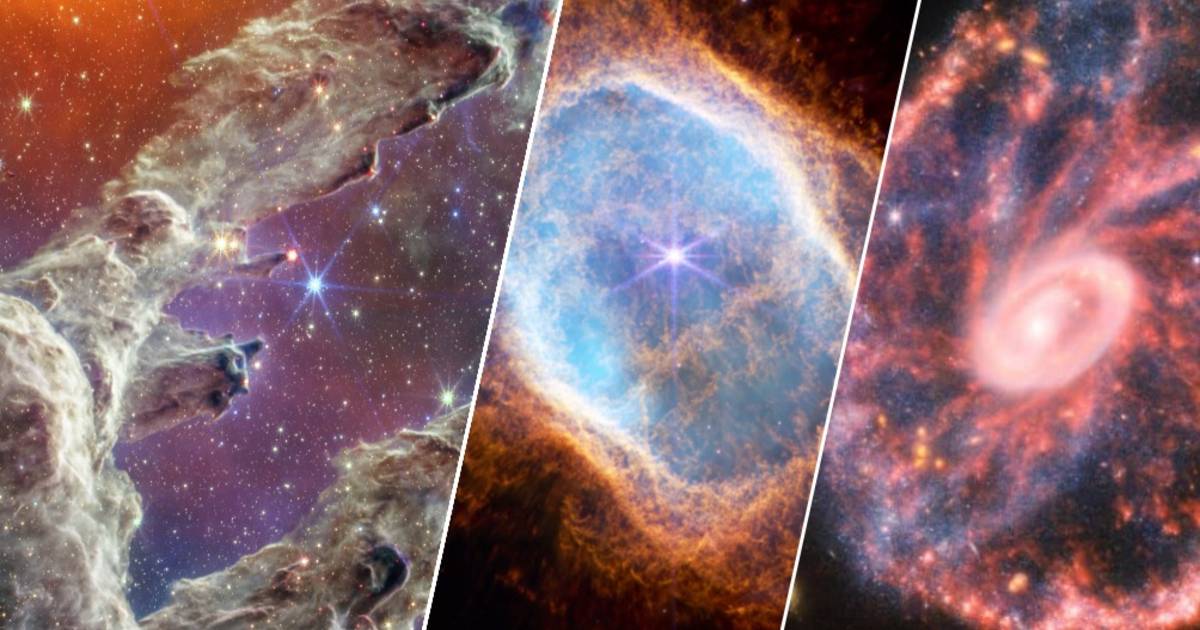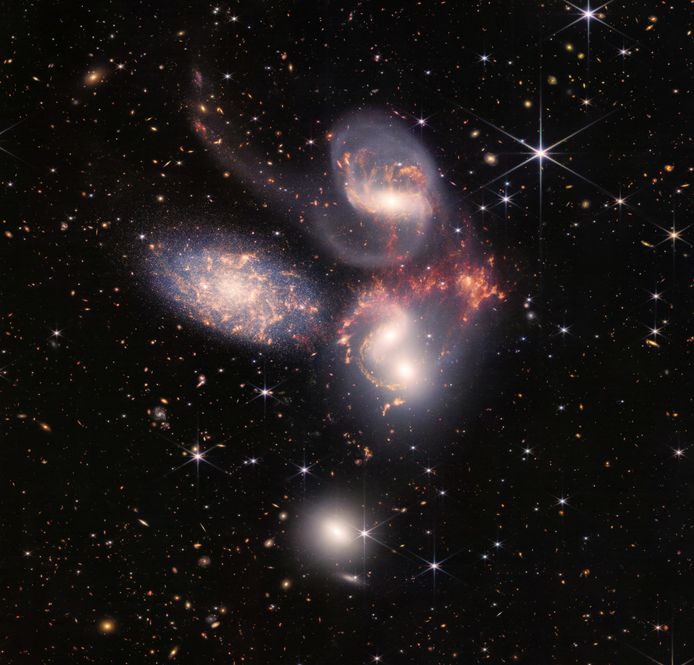Stargazing was taken to a whole new level last year with the launch of the James Webb Space Telescope. Several times this year we have been able to enjoy insanely beautiful and mysterious pictures of our universe. Here is an overview of the most beautiful places ever discovered in our universe. Science expert Martyn Peters also explains James Webb’s influence on science: “These beautiful images are only incidental and certainly not the main research.”
After a successful launch exactly one year ago, the James Webb telescope reached its destination on January 23rd. Then it was “parked” in orbit around the Sun at a stable spot in the Earth’s shadow. It uses as little energy as possible out there, has a clear view of the universe and can easily transmit images and measurements. The ambitious model is 1.5 million kilometers away from us.
“For now, the impact is still limited, because it’s just getting ready,” says Martijn Peters. “But it is now sending its first data and a large number of scientists are already working on it.” So it’s much more than just pretty pictures. “A lot of data is made available and anyone can do research on it. You can also take measurements if you ask,” says Peters.
First photos
It was a while before it was shared with the general public, but in July of this year we got a glimpse of the amazing images the telescope made for the first time. One of the first images included Stephan’s Quintet, a visual grouping of five galaxies. The image was incredibly sharp and contained over 150 million pixels.
“NASA loves to show off these images and they are also very beautiful, but many of these images are incidental and not the main investigation. The main task is to generate large amounts of scientific data,” says expert Peters.
James Webb’s first images included the Southern Ring Nebula. This is a slowly expanding shell of interstellar gas at a distance of about 2,000 light-years (a light-year is about 9.5 trillion km). The nebula was ejected thousands of years ago by the dying star at the center. In this cooling haze, small dust particles and various molecules, including hydrocarbon compounds that form the basis of life, are formed. In less than five billion years, our Sun will also swell into a red giant star and blow such an expanding nebula out into space.
In another image, what look like orange and blue brush strokes in an Impressionist painting, are clouds of gas and dust in the Carina Nebula, 7,600 light-years away. Massive new stars are forming in the cool, dusty caverns of this nebula complex; A birth process that can be studied in detail by Webb, because infrared radiation penetrates most dust clouds. As in other web images, the colors are not real (the human eye cannot perceive infrared). Different infrared wavelengths are visualized by different colours.
planets
James Webb also looked down on Neptune. Astronomers haven’t seen the outermost planet in the solar system so clearly since the Voyager 2 probe passed by Neptune in 1989. The telescope’s infrared view offers a new way to analyze the atmosphere, said Mark McCaughrean, science and exploration advisor at the European Space Agency (ESA). aerial.
Jupiter now has fewer secrets for us because of James Webb. Several images from James Webb have been combined into a composite image that gives Earth a new look at the gas giant. “You can see Jupiter’s Great Red Spot on the lower right,” says science expert Martin Peters. “This is a storm big enough to swallow the Earth.” Martijn also points out the faint rings and distant galaxies you can see in the background.
the smallest galaxy
At the beginning of this month, the telescope also discovered a very old galaxy that was not visible until now. The galaxy had formed “only” 350 million years after the Big Bang. “What we can expect with certainty is that the record for the smallest galaxy will be broken,” says Peters. “Looking at the infrared light deep in our universe, we can learn what the first hundred million years after the Big Bang looked like. This has been a mystery until now.”
James Webb can also stare at this wheel system. Until now, according to space agencies, this system has always been somewhat shrouded in mystery due to large amounts of dust. Hubble has also looked at this galaxy before, but the “wires” in the wheel, for example, are much more visible in the new image.
James Webb’s data again shows that the Cartwheel system is in transition. It may have been an ordinary galaxy like the Milky Way, but in the past there was a high-speed collision between a large spiral galaxy and a small galaxy that is not visible in the image. Non-collision shape and structure.
It’s a well-known image to space enthusiasts: “The Pillars of Creation.” It is one of the most beautiful sights in the universe and James Webb visited it again this year. What you see in the images are dense clouds of hydrogen gas and dust in the constellation of the Serpent, 6,500 light-years from Earth. The Hubble Telescope captured the magnificence of this space in 1995 and 2014.
better telescope
“James Webb will be able to work for at least 10 years, but maybe longer,” says Peters. There will also be a follow-up from NASA, the “Nancy Grace Roman Space Telescope.” It is already being worked on and once it is ready it will be able to scan much larger areas of the night sky. “It will also be better at looking for dark energy and even better at looking for exoplanets,” says Peters.
We close with this beautiful photo. It shows the core of M74, also known as the ghost galaxy. M74 is a spiral galaxy 32 million light-years away and composed of about 100 billion stars.
Unlimited free access to Showbytes? Which can!
Log in or create an account and never miss a thing from the stars.

“Total coffee specialist. Hardcore reader. Incurable music scholar. Web guru. Freelance troublemaker. Problem solver. Travel trailblazer.”















More Stories
GALA lacks a chapter on e-health
Weird beer can taste really good.
Planets contain much more water than previously thought